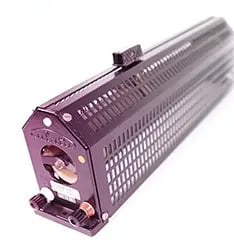Variable Power Resistors VS. modern Benchtop E-Loads
This article covers Loads up into the range of a few 100W. Loads in the kW-realm are a different animal which are not discussed here and today.
Variable Power Resistors
When testing any type of power source the traditional approach was to use a variable power resistor.
The functionality of these devices is easy to understand, they are simple passive components, a potentiometer.
This works well as long as we need a load with a constant resistance and take precautions to prevent overheating. Adjusting an exact resistance value can get tricky due to mechanical properties of the device.

E-Loads
E-Loads or Electronic Loads offer a vast array of additional functionality compared to the adjustable power resistors. The main functional difference is the ability to test the power source with a dynamic load.
As example we can take a look at the new EL30000A Series made by Keysight.
The shortlist of features:
- Test voltages up to 150 V
- Sink current up to 60 or 120 A
- Use operating modes: constant voltage (CV), constant current (CC), constant resistance (CR), constant power (CP)
- Display measurements, data logging, or scope view
- Save data internally or to an external USB flash drive
- Improve load regulation with four-wire remote sense
- Create dynamic load profiles with device's LIST function
- Connect with USB, LAN (LXI Core), and optional GPIB
We can set it to constant resistance mode to make it behave like our adjustable resistor. But we get the added benefit of precise control, logging of current and voltage curves and a full protection against overload.
The E-Load gives us full programmable and dynamic control over the parameters of the Load. We can easily simulate a battery with exact characteristics to test a battery charger.
We can generate load – spikes or sudden load dumps to see if the power-supply under test works as intended or produces unexpected transients.
The functional possibilities will suit all test scenarios from simple to highly complex.
Workspace
Using a state-of-the-art E-Load also cleans up our workspace significantly. The device already comes with built-in precise voltmeter, ammeter and power-meter. It also doubles down as datalogger with flexible sample rates so we can document our measurements efficiently. We can export the logged data to a CSV-File so we can store, visualize and use the data as needed.
If we need more than one load we can use dual- or multichannel E-Loads with independent inputs, each of them having the exact same functionality than the single channel device.
This translates to much less instruments and cabling on our workbench which makes our tests more time efficient to set up and reduces errors and costly mistakes dramatically.
And it saves space – A LOT.
Integration
E-Loads typically offer all the interfaces needed to integrate them into your automated test-environment. LAN and USB are standard with GPIB as an option.
Of course you can operate the E-Load also in stand alone mode and use the intuitive front panel controls to access the full functionality.
Safety
A very important aspect of using modern E-Loads instead of traditional adjustable resistors is workplace safety. The E-Loads are protected against overcurrent, overvoltage and overpower, which inherently includes overtemperature. This eliminates the dangers of overheated resistors to the employees, the equipment and even mitigates the potential fire hazard.
To illustrate this we put both the variable resistor and the E-Load under a pretty high load and take thermal images after a minute.

Under this specific load-conditions the variable resistor heats up to over 100°C while the E-Load’s thermal management keeps it in a very safe range of max. 30°C.
Admittedly we have overpowered the variable resistor quite a bit to make the point, but such overload conditions can happen unintended in day to day lab setups very easily.
Any risk assessment for lab and test environments should find all old-fashioned variable power resistors which are still in use and promote a re-evaluation of the situation.
At Computer Controls AG we can offer and support a wide range of E-Loads. We are happy to discuss your application in detail and help you to efficiently find the perfect device for your testing needs.



